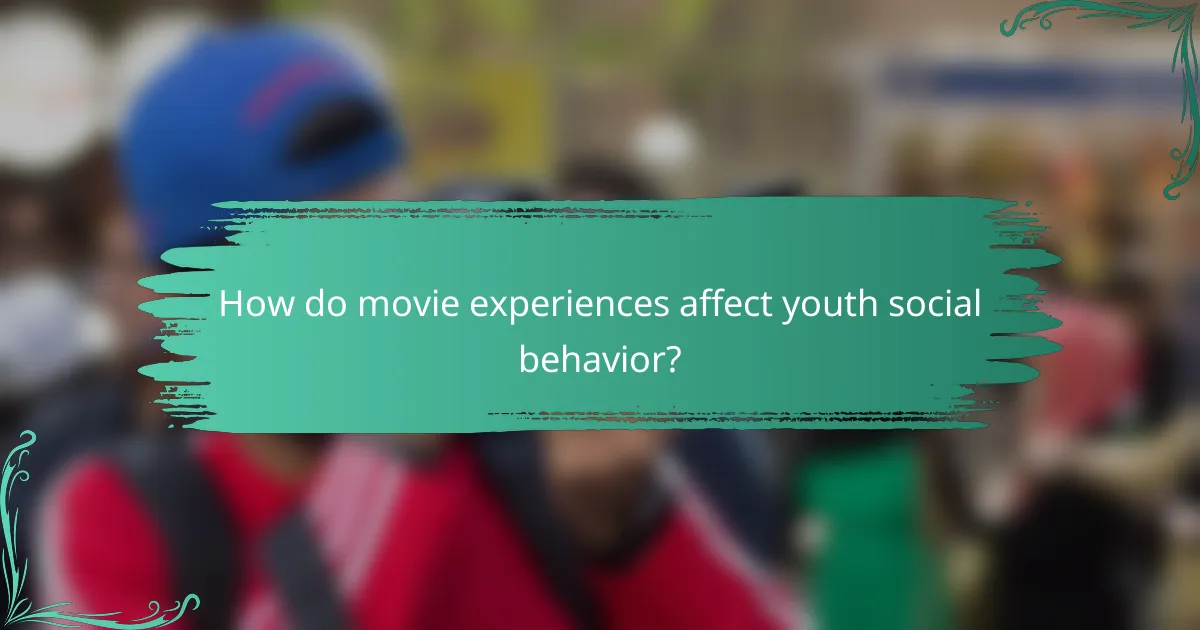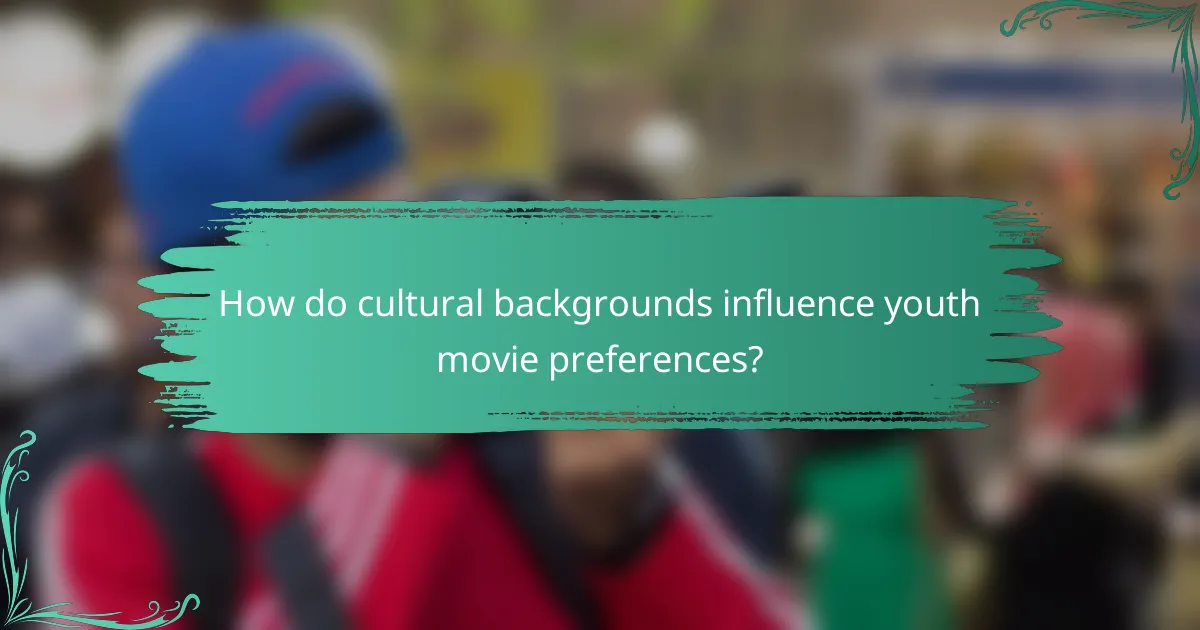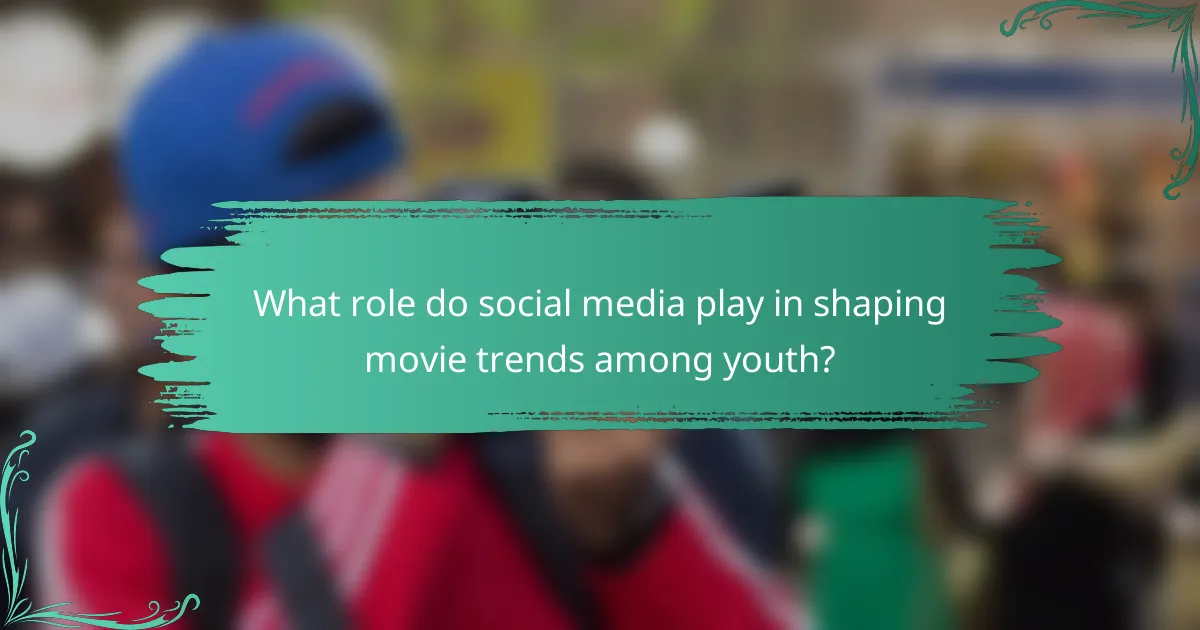Movies play a pivotal role in shaping youth culture by influencing trends, attitudes, and social behaviors. They not only reflect societal values but also dictate what is deemed popular among younger audiences, fostering connections and community involvement through shared cinematic experiences.

How do movies shape youth culture in the United States?
Movies significantly influence youth culture in the United States by shaping trends, attitudes, and social behaviors. They serve as a reflection of societal values and often dictate what is considered popular or acceptable among younger audiences.
Influence of blockbuster films
Blockbuster films often set the tone for youth culture by introducing new trends in fashion, language, and social norms. These films typically feature relatable characters and storylines that resonate with young audiences, making them powerful tools for shaping opinions and behaviors.
For example, movies like “The Breakfast Club” and “Mean Girls” have defined high school experiences for generations, influencing how youth perceive social hierarchies and relationships. The marketing strategies surrounding these films also amplify their reach, making them cultural phenomena that can impact youth identity.
Impact of streaming platforms
Streaming platforms have transformed how youth consume films, leading to a shift in cultural engagement. With on-demand access to a vast library of content, young viewers can explore diverse genres and narratives that were previously less accessible.
This accessibility fosters a more inclusive culture, allowing underrepresented voices to gain visibility. Additionally, binge-watching trends can create communal experiences among peers, as discussions about popular series or films become a significant part of youth social interactions.
Role of film festivals
Film festivals play a crucial role in shaping youth culture by showcasing independent films that often tackle relevant social issues. These events provide a platform for emerging filmmakers and encourage young audiences to engage with thought-provoking content that challenges mainstream narratives.
Attending film festivals can inspire youth to explore their creativity and consider careers in the film industry. Moreover, the networking opportunities available at these events can lead to collaborations that further enrich the cultural landscape, making them essential for fostering innovation among young filmmakers.

What trends are emerging from youth movie experiences?
Youth movie experiences are shaping several key trends that reflect changing preferences and cultural values. These trends include a growing interest in superhero genres, an emphasis on diverse storytelling, and a shift towards interactive cinema formats.
Popularity of superhero genres
Superhero films have become a dominant force in youth cinema, attracting large audiences and generating significant box office revenue. This genre resonates with young viewers due to its themes of empowerment, identity, and moral dilemmas, often featuring relatable characters who face extraordinary challenges.
Films from major franchises like the Marvel Cinematic Universe and DC Extended Universe frequently dominate ticket sales, with many titles grossing hundreds of millions of dollars worldwide. This popularity influences youth culture by inspiring fashion trends, social media discussions, and even fan conventions.
Rise of diverse storytelling
Diverse storytelling is increasingly prevalent in youth-oriented films, reflecting a broader range of experiences and backgrounds. This trend is driven by a demand for representation, as young audiences seek stories that resonate with their identities and cultural narratives.
Films like “Black Panther” and “Crazy Rich Asians” have not only achieved commercial success but have also sparked conversations about inclusivity in Hollywood. This shift encourages filmmakers to explore underrepresented voices, leading to richer narratives and a more varied cinematic landscape.
Shift towards interactive cinema
Interactive cinema is gaining traction among younger audiences, who crave immersive experiences that allow them to engage with the story. This trend includes formats like choose-your-own-adventure films and virtual reality experiences, which invite viewers to influence the narrative direction.
Platforms like Netflix have experimented with interactive storytelling, offering titles such as “Black Mirror: Bandersnatch” that let viewers make choices for the characters. This approach not only enhances engagement but also fosters a sense of agency, appealing to a generation accustomed to interactive digital environments.

How do movie experiences affect youth social behavior?
Movie experiences significantly influence youth social behavior by shaping their interactions, interests, and community involvement. These experiences often serve as a catalyst for forming friendships and establishing social norms among young people.
Fostering community engagement
Movies often bring youth together, creating a shared experience that fosters community engagement. Events like film screenings, festivals, or themed gatherings encourage social interaction and collaboration among peers.
For example, youth may organize local movie nights or participate in community film projects, enhancing their sense of belonging and teamwork. Such activities can lead to lasting friendships and a stronger community identity.
Influencing fashion trends
Film characters and their styles frequently inspire youth fashion trends, impacting what young people wear in their daily lives. Iconic outfits from popular movies can lead to a surge in demand for similar clothing items, as youth seek to emulate their favorite characters.
For instance, a blockbuster film featuring a unique fashion style may result in a noticeable increase in sales for specific clothing brands or styles, illustrating how cinema directly shapes youth fashion choices.
Shaping online interactions
Movies also influence how youth interact online, particularly through social media platforms. Young people often share their thoughts on films, create fan pages, or participate in discussions about movie themes, which can enhance their digital social networks.
Moreover, movie quotes and memes frequently circulate online, serving as common references that facilitate conversations among peers. This shared language can strengthen connections and foster a sense of community among fans.

What are the psychological effects of movies on young audiences?
Movies can significantly shape the psychological landscape of young audiences, influencing their emotions, identity, and mental health perceptions. The narratives and characters in films often resonate deeply with youth, impacting their development and worldview.
Emotional connection to characters
Young viewers often form strong emotional bonds with characters, which can lead to increased empathy and understanding of diverse perspectives. These connections allow youth to explore complex emotions in a safe environment, helping them process their feelings and experiences.
For example, a teenager might relate to a character facing bullying, which can validate their own experiences and encourage them to seek support. This emotional engagement can foster a sense of belonging and community among peers who share similar interests in films.
Influence on identity formation
Movies play a crucial role in shaping identity during formative years by presenting various lifestyles, values, and social norms. Young audiences often emulate characters they admire, adopting aspects of their personalities, fashion, and behaviors.
This influence can be positive, such as inspiring confidence or creativity, but it can also lead to negative outcomes if youth idolize harmful stereotypes or unrealistic standards. Parents and guardians should encourage discussions about the characters and themes in films to help youth critically assess their influences.
Impact on mental health perceptions
Films can significantly affect how young audiences perceive mental health issues, either by normalizing discussions around them or perpetuating stigma. Positive portrayals of mental health challenges can encourage youth to seek help and foster understanding among peers.
Conversely, negative or sensationalized depictions may lead to misconceptions and fear surrounding mental health. It is essential for parents and educators to provide context and support when discussing these themes, helping youth navigate their feelings and experiences related to mental health.

How do cultural backgrounds influence youth movie preferences?
Cultural backgrounds significantly shape youth movie preferences by affecting their tastes, values, and social norms. Factors such as regional traditions, language, and societal issues play a crucial role in determining which films resonate with young audiences.
Regional film popularity
Youth movie preferences often reflect regional film popularity, as local cinema tends to address familiar themes and narratives. For instance, in countries like India, Bollywood films dominate, while in South Korea, K-dramas and films are widely favored. These regional preferences can influence the types of stories that young people relate to and seek out.
Moreover, youth in different regions may gravitate towards genres that resonate with their cultural experiences, such as horror, romance, or action. Understanding these trends can help filmmakers create content that appeals to specific demographics.
Representation in cinema
Representation in cinema is vital for youth as it shapes their identity and self-perception. When young audiences see characters that reflect their cultural backgrounds, they are more likely to feel connected to the story. For example, films that showcase diverse ethnicities and experiences can empower youth by validating their own narratives.
However, the lack of representation can lead to feelings of alienation. Filmmakers should strive to include authentic portrayals of various cultures to foster inclusivity and acceptance among young viewers.
Cross-cultural collaborations
Cross-cultural collaborations in filmmaking can enrich youth movie experiences by blending diverse storytelling techniques and perspectives. Collaborations between filmmakers from different countries can lead to innovative narratives that appeal to a broader audience. For instance, co-productions between Hollywood and international cinema have produced films that resonate with youth globally.
These collaborations often introduce young viewers to new cultures and ideas, expanding their horizons. However, it’s essential for creators to approach these partnerships with sensitivity and respect for the cultures involved to avoid misrepresentation.

What role do social media play in shaping movie trends among youth?
Social media significantly influences movie trends among youth by facilitating rapid information sharing and creating a platform for engagement. Platforms like Instagram, TikTok, and Twitter allow young audiences to discover, discuss, and promote films, often leading to viral trends that can boost a movie’s popularity overnight.
Viral marketing campaigns
Viral marketing campaigns leverage social media to create buzz around a film, often using catchy hashtags, challenges, or memes that resonate with younger audiences. For example, a movie might launch a TikTok dance challenge related to a key scene, encouraging users to participate and share their versions, which amplifies visibility.
These campaigns can lead to significant increases in ticket sales, especially when they tap into current trends or cultural moments. Brands often collaborate with popular social media platforms to ensure their campaigns reach the intended demographic effectively.
Influencer endorsements
Influencer endorsements play a crucial role in shaping movie trends by providing authentic recommendations from trusted figures within youth culture. Influencers with large followings can create content that highlights a film’s unique aspects, making it more appealing to their audience.
When influencers share their thoughts on a movie through reviews, behind-the-scenes content, or themed merchandise, it can lead to heightened interest and engagement. Brands should choose influencers whose values align with the film’s message to ensure a genuine connection with potential viewers.
